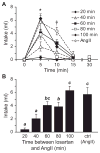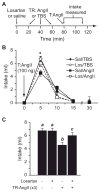Repeated administration of angiotensin II reduces its dipsogenic effect without affecting saline intake
- PMID: 20228119
- PMCID: PMC2874118
- DOI: 10.1113/expphysiol.2010.052191
Repeated administration of angiotensin II reduces its dipsogenic effect without affecting saline intake
Abstract
Angiotensin II (Ang II) acts at central type 1 (AT(1)) receptors to increase intake of water and saline. In vitro studies demonstrated rapid desensitization of the AT(1) receptor after Ang II exposure, and behavioural studies in rats suggest that exposure to Ang II decreases the dipsogenic potency of subsequent Ang II. Nevertheless, the effect of repeated Ang II injections on saline intake remains untested, and a reliable protocol for examining this purported behavioural desensitization has not emerged from the literature. To address these issues, we established a reliable approach to study Ang II-induced dipsetic desensitization and used this approach to test the requirement of central AT(1) receptors and the specificity of the effect for water intake. Rats given a treatment regimen of three injections of Ang II (300 ng, intracerebroventricular), each separated by 20 min, drank less water than control rats after a subsequent test injection of Ang II. The effect was relatively short lasting, dependent on the dose and timing of Ang II, and was almost completely blocked by the AT(1) receptor antagonist losartan. In further testing, when rats were given access to both water and 1.5% saline, animals that received an Ang II treatment regimen drank less water than control animals, but saline intake was unaffected. These data support previous suggestions that Ang II-induced water and saline intakes are separable. Given the role of G protein uncoupling in desensitization of the AT(1) receptor, these data are consistent with the emerging hypothesis that AT(1) receptor G protein-dependent intracellular signalling pathways are more relevant for water, but not saline, intake.
Figures






Similar articles
-
Acute repeated intracerebroventricular injections of angiotensin II reduce agonist and antagonist radioligand binding in the paraventricular nucleus of the hypothalamus and median preoptic nucleus in the rat brain.Brain Res. 2014 Oct 2;1583:132-40. doi: 10.1016/j.brainres.2014.07.053. Epub 2014 Aug 7. Brain Res. 2014. PMID: 25108041 Free PMC article.
-
Mitogen-activated protein kinase is required for the behavioural desensitization that occurs after repeated injections of angiotensin II.Exp Physiol. 2012 Dec;97(12):1305-14. doi: 10.1113/expphysiol.2012.065771. Epub 2012 May 11. Exp Physiol. 2012. PMID: 22581747 Free PMC article.
-
Role of thromboxane receptors in the dipsogenic response to central angiotensin II.Am J Physiol Regul Integr Comp Physiol. 2002 Mar;282(3):R865-9. doi: 10.1152/ajpregu.00328.2001. Am J Physiol Regul Integr Comp Physiol. 2002. PMID: 11832409
-
Properly timed exposure to central ANG II prevents behavioral sensitization and changes in angiotensin receptor expression.Am J Physiol Regul Integr Comp Physiol. 2014 Dec 15;307(12):R1396-404. doi: 10.1152/ajpregu.00373.2014. Epub 2014 Oct 29. Am J Physiol Regul Integr Comp Physiol. 2014. PMID: 25354729 Free PMC article.
-
Losartan inhibition of angiotensin-related drinking and Fos immunoreactivity in hypertensive and hypotensive contexts.Brain Res. 1996 Dec 2;742(1-2):253-9. doi: 10.1016/s0006-8993(96)01016-5. Brain Res. 1996. PMID: 9117402
Cited by
-
Acute repeated intracerebroventricular injections of angiotensin II reduce agonist and antagonist radioligand binding in the paraventricular nucleus of the hypothalamus and median preoptic nucleus in the rat brain.Brain Res. 2014 Oct 2;1583:132-40. doi: 10.1016/j.brainres.2014.07.053. Epub 2014 Aug 7. Brain Res. 2014. PMID: 25108041 Free PMC article.
-
Sex Differences in the Behavioral Desensitization of Water Intake Observed After Repeated Central Injections of Angiotensin II.Endocrinology. 2018 Feb 1;159(2):676-684. doi: 10.1210/en.2017-00848. Endocrinology. 2018. PMID: 29186291 Free PMC article.
-
Investigation into the specificity of angiotensin II-induced behavioral desensitization.Physiol Behav. 2012 Feb 28;105(4):1076-81. doi: 10.1016/j.physbeh.2011.12.003. Epub 2011 Dec 13. Physiol Behav. 2012. PMID: 22192708 Free PMC article.
-
Associative learning contributes to the increased water intake observed after daily injections of angiotensin II.Physiol Behav. 2017 Oct 1;179:340-345. doi: 10.1016/j.physbeh.2017.07.005. Epub 2017 Jul 4. Physiol Behav. 2017. PMID: 28687177 Free PMC article.
-
Mitogen-activated protein kinase is required for the behavioural desensitization that occurs after repeated injections of angiotensin II.Exp Physiol. 2012 Dec;97(12):1305-14. doi: 10.1113/expphysiol.2012.065771. Epub 2012 May 11. Exp Physiol. 2012. PMID: 22581747 Free PMC article.
References
-
- Billet S, Bardin S, Verp S, Baudrie V, Michaud A, Conchon S, Muffat-Joly M, Escoubet B, Souil E, Hamard G, Bernstein KE, Gasc JM, Elghozi JL, Corvol P, Clauser E. Gain-of-function mutant of angiotensin II receptor, type 1A, causes hypertension and cardiovascular fibrosis in mice. J Clin Invest. 2007;117:1914–1925. - PMC - PubMed
-
- Buggy J, Fisher AE. Evidence for a dual central role for angiotensin in water and sodium intake. Nature. 1974;250:733–735. - PubMed
-
- Coghlan JP, Considine PJ, Denton DA, Fei DT, Leksell LG, McKinley MJ, Muller AF, Tarjan E, Weisinger RS, Bradshaw RA. Sodium appetite in sheep induced by cerebral ventricular infusion of angiotensin: comparison with sodium deficiency. Science. 1981;214:195–197. - PubMed
-
- Conchon S, Peltier N, Corvol P, Clauser E. A noninternalized nondesensitized truncated AT1A receptor transduces an amplified ANG II signal. Am J Physiol. 1998;274:E336–345. - PubMed
Publication types
MeSH terms
Substances
Grants and funding
LinkOut - more resources
Full Text Sources
Research Materials
Miscellaneous

